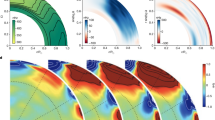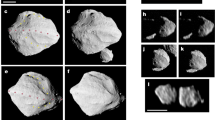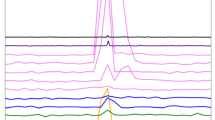Abstract
THE molecular ion H3+ occupies a central position in theoretical models of interstellar chemistry1,2. It forms readily in hydrogen-rich interstellar gas clouds when ionized H2 reacts with neutral H2. The H3+ ion can then donate a proton to oxygen, carbon and other heavy atoms. From this beginning nearly 100 different inter-stellar molecules are formed, such as the reactive hydroxyl radical OH, neutral CO, ethanol, the linear polyacetylenes HCxN and cyclic species such as cyclopropenylidene, C3H3. But in spite of a decade of searching3,4, H3+ has eluded detection except in the hydrogen-rich atmosphere of Jupiter5. Here we present evidence for the presence of H3+ in the envelope of supernova 1987A, where it is produced by an unusual chemistry in which excited hydrogen atoms are the main source of molecule formation. Infrared spectra of SN1987A (ref. 6) in the first few hundred days after the explosion contain two previously unidentified peaks which we attribute to H3+. Chemical modelling produces quantities of H3+ consistent with the observed peak intensities, and also predicts significant amounts of HeH+, which may be responsible for some weaker features in the spectra.
This is a preview of subscription content, access via your institution
Access options
Subscribe to this journal
Receive 51 print issues and online access
$199.00 per year
only $3.90 per issue
Buy this article
- Purchase on Springer Link
- Instant access to full article PDF
Prices may be subject to local taxes which are calculated during checkout
Similar content being viewed by others
References
Suzuki, H. Prog. theor. Phys. 62, 936–947 (1979).
Herbst, E. & Klemperer, W. Astrophys. J. 185, 505–513 (1973).
Geballe, T. R. & Oka, T. Astrophys. J. 342, 855–859 (1989).
Black, J. H., van Dishoeck, E. F. & Woods, R. C. Astrophys. J. 358, 459–467 (1990).
Drossart, P. et al. Nature 340, 539–541 (1989).
Meikle, W. P. S., Allen, D. A., Spyromilio, J. & Varani, G.-F. Mon. Not. R. astr. Soc. 238, 193–223 (1989).
Oka, T. & Geballe, T. R. Astrophys. J. 351, L53–56 (1990).
Maillard, J.-P., Drossart, P., Watson, J. K. G., Kim, S. J. & Caldwell, J. Astrophys. J. 363, L37–40 (1990).
Miller, S. & Tennyson, J. Astrophys. J. 335, 486–490 (1988).
Kao, L., Oka, T., Miller, S. & Tennyson, J. Astrophys. J. Suppl. 77, 317–329 (1991).
Lucy, L. B., Danziger, I. J. & Gouiffes, C. Astr. Astrophys. 243, 223–229 (1991).
Phillips, M. M. & Williams, R. E. in Supernovae (ed. Woosley, S. E.) 36 (Springer, New York, 1991).
Xu, Y., McCray, R., Oliva, E. & Randich, S. Astrophys. J. (in the press).
Lepp, S., Dalgarno, A. & McCray, R. Astrophys. J. 358, 262–267 (1990).
Amano, T. Astrophys. J. 329, L121–124 (1988).
Adams, N. G. & Smith, D. in Astrochemistry (ed. Vardya, M. S. & Tarafdar, S. P.) 1 (Reidel, Dordrecht, 1986).
Author information
Authors and Affiliations
Rights and permissions
About this article
Cite this article
Miller, S., Tennyson, J., Lepp, S. et al. Identification of features due to H3+ in the infrared spectrum of supernova 1987A. Nature 355, 420–422 (1992). https://doi.org/10.1038/355420a0
Received:
Accepted:
Issue Date:
DOI: https://doi.org/10.1038/355420a0
This article is cited by
-
Astrophysical detection of the helium hydride ion HeH+
Nature (2019)
-
Discovery of the first molecular ion in the Universe
Nature Astronomy (2019)
-
Dust in Supernovae and Supernova Remnants I: Formation Scenarios
Space Science Reviews (2018)
-
The temperature dependence of electron-ion recombination in hydrogen plasma
Czechoslovak Journal of Physics (2004)
Comments
By submitting a comment you agree to abide by our Terms and Community Guidelines. If you find something abusive or that does not comply with our terms or guidelines please flag it as inappropriate.



